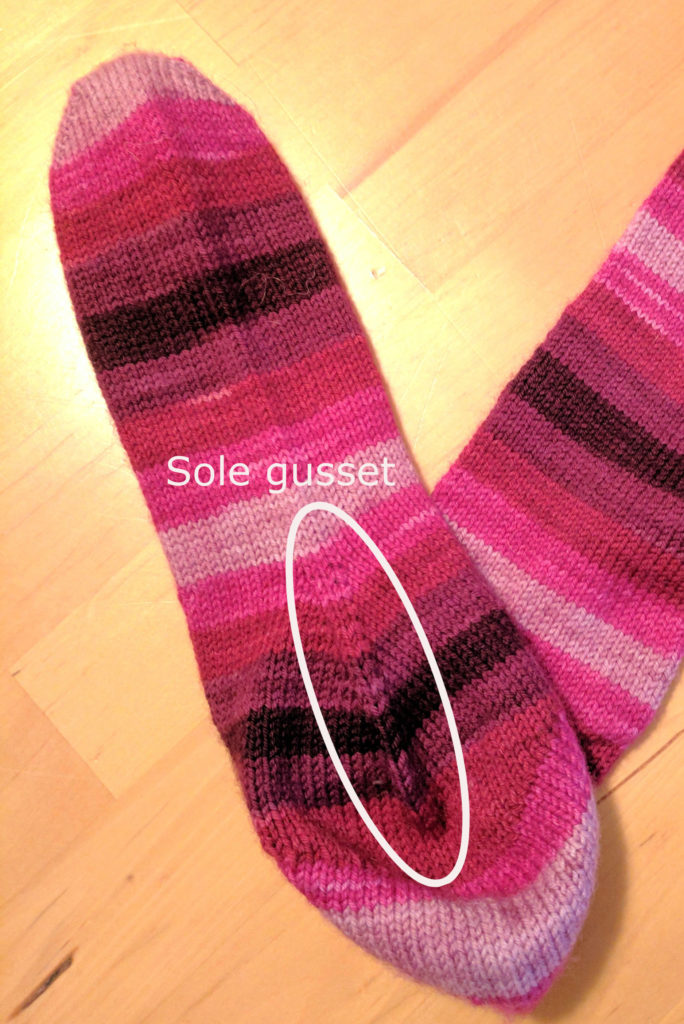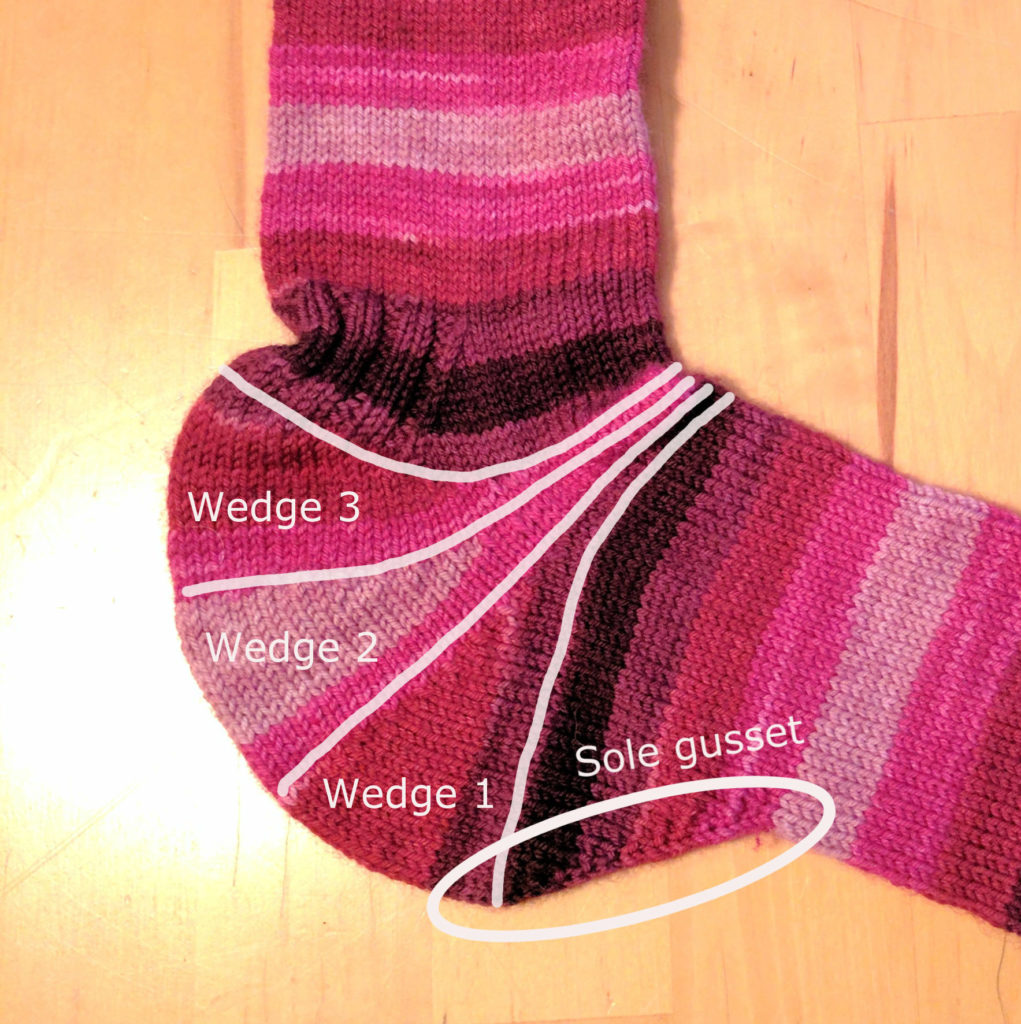In a recent post I talked about my sock recipe. You may be wondering what exactly that is. So I’m going to tell you. A sock recipe is your own style of sock pattern. It’s where you take bits and pieces of sock patterns that you like or bits and pieces of sock patterns that written yourself and put them together to make your own standard, go-to sock pattern. It’s a little Frankenstein sock that’s all your very own. It took me a lot of experimentation to come with a sock recipe that I really and truly love. I did several recipes trying out different toes and different heels and such but there was always something just not right about each one. So the one that I finally come up with that you can see here on Ravelry is my go-to mostly because I finally don’t need a piece of paper or notes to tell me exactly what my next step is or precisely what to do next.
I’m going to talk a little bit about my recipe and how I ended up with this particular one. Let’s start at the beginning. Let’s start with the cast on. No wait. Let’s start before the cast on. Let’s start with the needles. I’m still a pretty big fan of double pointed needles, especially for small gauge projects like socks. But I lug my socks around a lot. Constantly. My sock is always with me. So having all these DPNs sticking out everywhere in my project bag which was thrown into my backpack which is thrown into the trunk of my car isn’t convenient. It can be a downright mess if those needles start slipping and stitches are bitches and fall off the needle. I have one of these cool little sock stitch holders but I can’t ever find it when I need it. Maybe I should buy a few more. But I’ve found that I really and truly love the convenience of knitting socks on one long circular needle. They don’t roll down the aisle at the theatre, either, allowing you to ‘make friends’ with the people directly in front of you for the next four rows as you wiggle under their chairs in search of your dropped dpn. Ask me how I know.
With needles chosen, I am ready to cast on. Do I cast on forty-some stitches and begin at the cuff of the sock? Or cast on a couple of dozen and begin at the toe? I learned to knit socks, as most of us have, going top down. I had a lot of problems with the cast on being too tight to fit around my calf until the Twisted German cast on saved my leg from handmade-sock-tourniquet hell. Twisted German is a very stretchy type of long tail cast on where you pick up one more string along the way. But back when I was doing two socks on one long circular needle, I tried Judy’s Magic cast on for a pair of toe up socks and never looked back. I was totally sold on toe up socks. That cast on definitely lives up to it’s magical name.
One of the other reasons why I like a toe up sock on a circular needle is because I feel that it’s easier to try on the sock as I go. With a top down sock I don’t know how the heel fits until nearly all of the sock is knit. Whereas on a toe up I can tell immediately after I’ve made the heel if I like to heel or not.
I usually cast on ten or twelve stitches on each of the two needle ends depending on how thick the sock yarn is, then increase 4 stitches every other row until I get to 24 or 26 on each side of the sock. I run with the stockinette for a while until I reach the area where the instep of my foot starts to get bigger. That’s when I start doing a double increase in the middle of the sole of the sock. I like putting the gusset on the sole because it is super comfortable for me, and doesn’t interfere with any pattern that I may be knitting on the top of the sock. It doesn’t show up at all when you’re wearing the sock and I don’t feel it at all on the bottom of my foot because it hits the spot of my foot where the arch is.
To do the gusset, I add two stitches to the middle of every other sole row until… Well that’s where the Sweet Tomato heel comes in. The Sweet Tomato heel does not call for a gusset on the sock. It’s a short row heel that usually fits similarly to an afterthought heel. But I’ve found that I like a little more wiggle room for my heel, so I put in the aforementioned gusset on the sole of the sock. But the Sweet Tomato heel uses two-thirds of the stitches of your sock circumference. This usually means moving stitches from one needle to the other in order to have the correct number of stitches on the needle to work the heel. So when I put my gusset in, I just increase on that half of the sock until I reach the required number of stitches for the Sweet Tomato heel! Easy as pie. Or easy as math. Which may be a bit more fiddly than pie. Unless you suck at making crust. But that’s another blog post for another time.

So when I do the gusset, I add two stitches to the middle of every other sole row until the number of stitches on that side of the sock comprises two-thirds of the total number of stitches of the sock. Now, we’re going to do some math here. I SAW YOUR EYES ROLL UP INTO YOUR HEAD! Stop that! Because it’s not even really math**. Watch this: I’m going to increase the number of stitches on one side of the sock so that the number of stitches on that side equals two-thirds of whatever my NEW total of stitches will be. Now when I hypothetically get to the point where all of my increases are done, if two-thirds of my stitches are on one needle, then one-third of my stitches are on the other needle. And guess what! I already know how many stitches I have on that other needle! I have 24 or 26 or so, right? So I just double that number to know what number of stitches to increase to on the one side (Which will be the sole.) of my sock.
After increasing for the heel, I usually do three Sweet Tomato heel wedges. Sometimes I only do two. I really have to try on the sock a couple of times to decide whether to do two or three. Right after I do the heel wedges, I start decreasing gussets on each side of the bottom half of the sock. I put my stitch markers 8 stitches or so in from each edge and decrease every other row. At the same time, I slide in some 2×2 rib between the decrease gussets. This keeps the back of the… is that the heel area? Not really. The back of that piece of sock that keeps your achilles tendon warm. It keeps that snug up and looking good. Once those gussets and ribbing is done, it’s stockinette, stockinette all the way home!

Er, mostly home. Stockinette all they way to some 2×2 ribbing at the top of the sock. And then a bind off! Now the opposite side of getting out of doing a stretchy cast on by doing a toe up sock is that you need a nice stretchy bind off. There are a few excellent tried and true methods out there. Elizabeth Zimmerman’s (Insert genuflect here) sewn bind off was always by go-to. I’ve used Jeny’s Surprisingly Stretchy Bind Off as well. But the one I keep going back to over and over again lately is a picot bind off that Lorena taught me years and years ago. You just cast on two stitches (Knit them on, or use a backwards loop), then bind off four stitches. So easy peasy that I had to ask her several times over several pairs of socks to remind me how she did it. But now I’ve got it strong!
What about you?! What’s your sock recipe? I’ll be looking for a sweater recipe soon, so please share any ideas pertinent to that with me too!
** Do you want to see the math? Yeah, here’s the math: x = .333 * (24 + 24 + x) I had to plug that shit into an online algebra calculator to figure out how it works and I still don’t know if it’s even correct.
